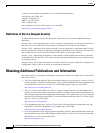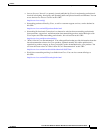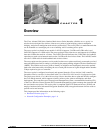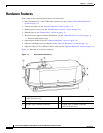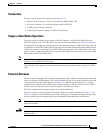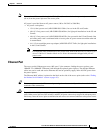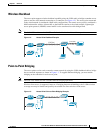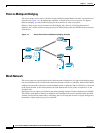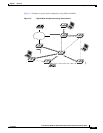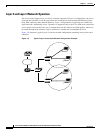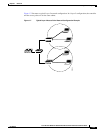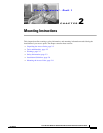
1-6
Cisco Aironet 1500 Series Outdoor Mesh Access Point Hardware Installation Guide
OL-9977-05
Chapter 1 Overview
Network Configuration Examples
Metal Enclosure
The access point uses a metal enclosure that can accommodate both indoor or outdoor operating
environments and an industrial temperature operating range of –40°C (–40°F) to +55°C (+131°F). The
access point complies with NEMA Type 4X and IP66 requirements from IEC60529.
The access point is shipped with a mounting plate attached to the unit.
Note When the access point is mounted indoors, the antennas must also be mounted indoors.
Optional Hardware
Some of the access point hardware options are listed below:
• Pole mount kit (AIR-ACCPMK1500=)-—provides hardware for mounting the access point to the top
of a metal pole, such as a streetlight pole.
• Streetlight power tap adapter (AIR-PWR-ST-LT-TAP=)—connects to the light control connector on
a streetlight pole and provides AC power to the access point.
• Outdoor rated Ethernet cable (AIR-ETH1500-150=)—used to supply Ethernet and optional DC power
to the access point.
• Power injector (AIR-PWRINJ1500=)—provides power-over-Ethernet (PoE) to the access point.
• AC power cord (for additional information, refer to the “Multiple Power Sources” section on
page 1-4).
Network Configuration Examples
The access point is a wireless device designed for wireless client access and point-to-point bridging,
point-to-multipoint bridging, and point-to-multipoint mesh wireless connectivity. The access point
provides 5-GHz backhaul capability to link with another access point to reach a wired network
connection or to provide repeater operations for other access points.
The access point plays two primary radio roles: a root access point ( hereafter called a RAP) or a non-root
access point (hereafter called a MAP). When the access point has a wired Ethernet connection to the
controller (through a switch), the radio role is called a RAP. A RAP is a parent node to any bridging or
mesh network. A controller can support one or more RAPs, each one parenting the same or different
wireless networks. There can be more than one RAP for the same mesh network for redundancy. RAPs
also support wireless clients on the band not being used for the backhaul interface.
When the access point does not have a wired Ethernet connection to the controller (through a switch),
the radio role is called a MAP. The MAPs have a wireless connection (through the backhaul interface)
to other MAPs and finally to a RAP with an Ethernet connection through a switch to the controller.
MAPs may also have a wired Ethernet connection to a local LAN and serve as a bridge endpoint for that
LAN (using a point-to-point or point-to-multipoint bridge connection). MAPs also support wireless
clients on the band not used for the backhaul interface.



